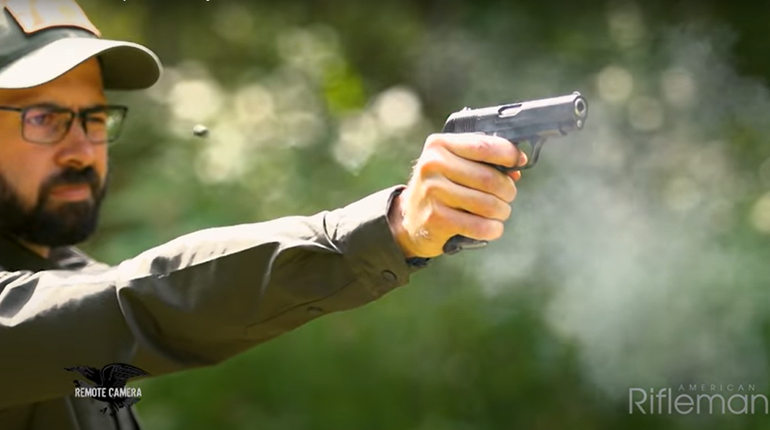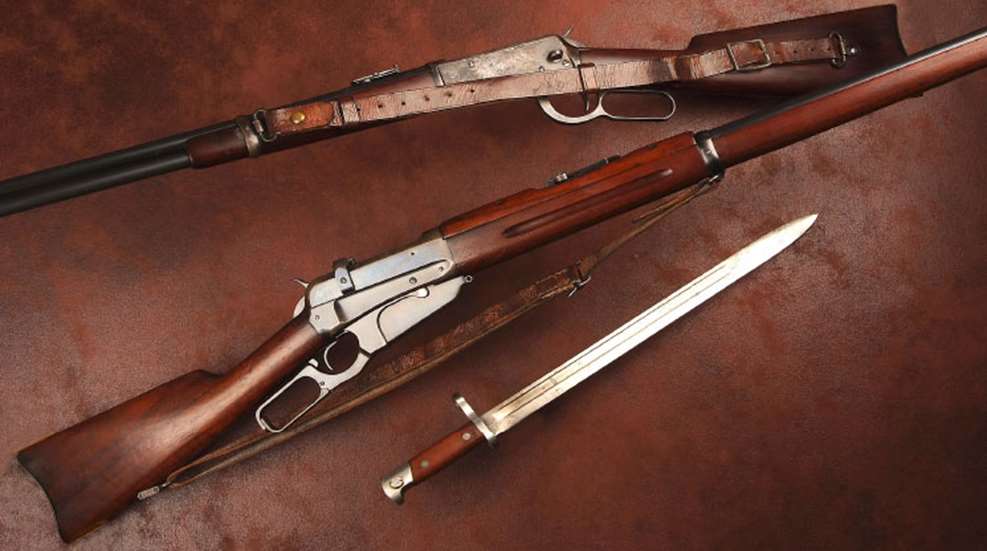
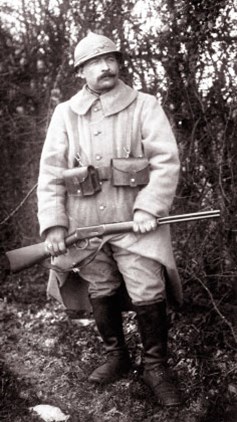 Even to the most disinterested, the Winchester lever-action’s very profile is recognizable, making it a true icon of the American West. What is not generally known is that Winchester lever-actions were, in their day, cutting-edge military rifles. And they proved effective combat arms from the American Civil War through World War I, despite the fact that they were never awarded a large U.S. military contract.
Even to the most disinterested, the Winchester lever-action’s very profile is recognizable, making it a true icon of the American West. What is not generally known is that Winchester lever-actions were, in their day, cutting-edge military rifles. And they proved effective combat arms from the American Civil War through World War I, despite the fact that they were never awarded a large U.S. military contract.
The earlier Winchester lever-actions (the Models 1866, 1873 and 1876) shared the Henry rifle’s toggle bolt system but offered Nelson King’s patented loading gate on the receiver’s right. Although durable and dependable, the toggle bolt could not handle loads more powerful than handgun cartridges. That became a limiting factor as cartridges, particularly military rifle cartridges, became more powerful during the 1870s. Ultimately, Winchester would turn to arms designer John M. Browning to overcome that shortcoming.
The first lever-action to bear the Winchester name, the Model 1866, was an improved version of the Henry rifle. The Model 1860 Henry was state-of-the-art technology—possessing rapid fire capability and generous magazine capacity—when used by Union soldiers during the American Civil War.

France was so impressed that its navy considered adopting the Winchester Model 1866. Rifle trials were conducted on the French frigate Semiramis in 1868. A report praised the Model 1866’s ability to fire quickly. The French navy planned to take advantage of the guns’ capabilities by placing them with sailors in crow’s nests (Babies dans les hunes) so as to lay rapid fire down on the decks of enemy ships. In February 1870, recommendations were made to adopt the Model 1866, designated by the French as the “Carabine Henry – Winchester.” The Franco-Prussian War (July 1870 to May 1871) interrupted its possible adoption, but the need for rifles created an opportunity for Winchester.
Although France did not officially adopt the Winchester Model 1866, several thousand were purchased during the Franco-Prussian War in a mad scramble to gather arms. France purchased 3,000 Model 1866 rifles with 16-round-capacity magazines and 3,000 with 13-round magazines; included with the purchase were 4.5 million rounds of .44 Henry ammunition. These were distributed to various units, including combat troops, and were the only foreign rifles to be retained for an extended period of time after the war. The Model 1866 became the standard rifle for the 630 gendarmes of the Corsican 17th Legion.
The Model 1866 was also purchased by the Ottoman Empire and used against the Imperial Russian Army in the Russo-Turkish War (1877 to 1878). The Ottomans purchased 45,000 muskets and 5,000 carbines in 1870 and 1871. A portion of those was used in 1877, during the Siege of Plevna. The Russian army suffered tremendous losses when it attacked the Ottomans, in part due to the use of the Winchester rifles.
Imperial Russia took note and began a search for a repeating rifle, which resulted in the development and adoption of the Mosin-Nagant years later. Still, the repeating firepower of the Winchester lever-action did not spur large military purchases, as Winchester lever-actions were more costly than single-shot and bolt-action rifles.
During the 1870s, single-shot breechloaders firing powerful cartridges dominated the military rifle market. That was demonstrated by the large quantity of single-shot Rolling Block rifles sold by the Remington Arms Co. around the world. The concept of a medium-powered cartridge being fired rapidly from a rifle with a large magazine was not embraced by most military leaders. Their belief was that common soldiers would waste ammunition if given repeating rifles and that Winchester repeating rifles were not robust enough and too complicated for military service. Even so, Winchester continued to develop the lever-action repeater with the designs of John Browning.
In keeping with the function of Winchester’s lever-actions, Browning designed a new action that was much stronger but retained the under-receiver lever and handling qualities that were hallmarks of earlier Winchesters. The new approach used vertical bolts that gave the new models the ability to fire more powerful cartridges.
The first Browning-designed lever-action was the Model 1886, followed by a smaller, lighter version, the Model 1892. The Model 1886 could handle the .45-70 Gov’t cartridge adopted by the U.S. Army, as well as similarly powerful chamberings. The Model 1892 was better-suited for revolver and lighter rifle cartridges. Even so, the introduction of smokeless powder in the 1880s made these blackpowder models virtually obsolete. Again, John Browning provided a solution.
With the advent of smokeless powder, Winchester offered the Browning-designed Models 1894 and 1895. The stronger receivers could handle the higher chamber pressures of smokeless powder. The Model 1895 was specifically designed with martial applications in mind. The receiver was made to handle military cartridges, and a box magazine was incorporated instead of the traditional tubular magazine. The gun was evaluated in 1895 at the New York National Guard rifle trials. Although the trials did not result in adoption, a number of rifles chambered in .30-40 Krag were purchased a few years later by the U.S. War Dept. for use in the Spanish-American War. Still, military acceptance and large orders of lever-action rifles would elude Winchester until the advent of the First World War.
The realities of World War I brought about a change of heart toward Winchester’s lever-actions. The Allies’ extreme shortages encouraged the purchase of large quantities of rifles from American manufacturers. Great Britain, France and Imperial Russia purchased Winchester lever-actions for frontline and secondary use. Many were “off the shelf” models, which included the Models 1886, 1892 and 1894. Some were ordered with specialized requirements. Contracts were signed for modified Model 1894 and Model 1895 rifles. The size of the purchases varied; the Model 1886 was the least-procured, while the Model 1895 accounted for the greatest numbers sold.
Great Britain
Great Britain purchased three different Winchester lever-action models: the Model 1886, Model 1892 and Model 1894. The first wartime purchase, by the Royal Flying Corps, was for fewer than 50 Model 1886 Winchesters chambered in .45-90 Win. Special cartridges were developed with incendiary bullets designed to ignite the hydrogen gas in German airships and balloons. The rifles allowed the Royal Flying Corps to counter this airborne threat while they were developing more effective arms.
To allow all standard-issue Lee-Enfield rifles to be available for the front, Winchester repeaters were also purchased by the Royal Navy, and they were used shipboard for guard duty and mine clearing, the details of which are unknown. The Royal Navy acquired 20,000 Model 1892 rifles in .44-40 Win. and approximately 5,000 Model 1894 carbines in .30 WCF (.30-30 Win.). Those Winchesters, along with some Remington Rolling Block rifles, were replaced in 1915.
France
In order to prioritize issue of the standard infantry rifle—the Model 1886 Lebel—to frontline troops, France turned to obsolete Gras Model 1874 rifles for service and support soldiers. Almost immediately, the French embarked on a program to convert blackpowder Gras rifles to the smokeless 8 mm Lebel cartridge. The conversion proved difficult, and progress was slow. Unable to produce enough standard-issue Lebel rifles or convert enough Gras rifles, France contracted with Winchester and Remington to arm rear-echelon soldiers. Remington was contracted for a modified version of its Rolling Block rifle, while Winchester received a contract for 15,100 Model 1894 carbines.
The contract required the addition of metric graduations to Winchester’s No.44A rear sight and the addition of sling swivels on the left side of the buttstock and barrel band. The sling swivels were specifically required so that the carbine could be carried en bandoulière (the French term for carrying a carbine across the back). These added features were unique to the French contract. The carbines were issued to motorcycle couriers, artillery troops and transport units. Model 1894s also found their way to balloon units, and some may have been used by airmen in their aircraft.
After the war, the French Winchester Model 1894s were sold by the French government to unknown buyers. Some bear Belgian proofmarks, as they were transferred through Belgium. The Belgian proofs have led many to incorrectly assume that those guns were purchased by the Belgian Congo.

Imperial Russia helped Winchester realize its largest military sales since the introduction of the lever-action rifle. A total of 300,000 Model 1895 rifles were ordered in two contracts, one in 1914 and another in 1915.
Known as the “Russian Musket,” this Model 1895 variant was adapted to fire the Russian rimmed 7.62x54 mm Model 1908 cartridge. The contracts required the addition of a bayonet lug and stripper-clip guides mounted on the receiver. The rifle had to accept the standard Russian Mosin-Nagant stripper clip and the rear sight needed to be graduated in Russian arshins. Those features made the Model 1895 the equal of any rifle on the battlefield. It saw the most use with frontline fighting units, and was issued to units formed in Russia’s western provinces of Finland, Poland and Latvia. Period photographs show large military formations of Imperial soldiers holding Model 1895 Russian Muskets. The surviving Model 1895 rifles were put in storage after the Russian Civil War.
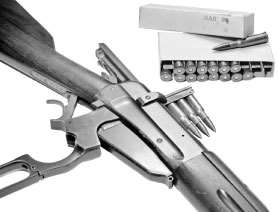
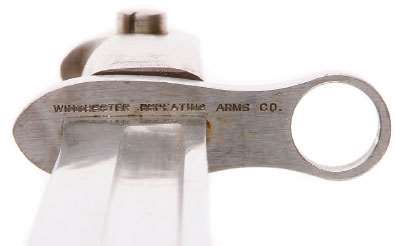
The lever-action proved itself a worthy combat rifle from its first use in the American Civil War through to World War I. In every instance the results were more than satisfactory.
Period photographs courtesy of Commandant Philippe François, John Adams-Graf and Christophe Larribère














